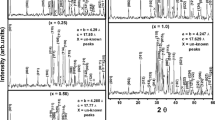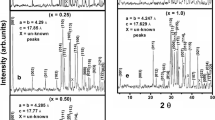Abstract
(Cu0.5Tl0.5)(Ba2–yCay)(CaMg)(Cu3–xZnx)O10–δ (y = 0, 1; x = 0, 2, 2.5, 2.8, 3) and (MxTl1–x)(BaCa)(CaMg) Zn3O10–δ (M = Ag, K; x = 0, 0.5) superconductors are synthesized for the studies of role of spin density waves in the mechanism of high Tc superconductivity. Such compounds are synthesized by reducing the thickness of the charge reservoir layers and distance among various CuO2/ZnO2 planes; decreasing the thickness of charge reservoir layers (CRLs) and distance among the various CuO2/ZnO2 planes increase the spin–spin interaction. All such samples were prepared by a two-step solid-state reaction (SSR) method at 860 °C and have shown orthorhombic crystal structure in which volume (V) of the unit cell suppresses with the doping of Ca, showing that partial substitution of Ca at the Ba site suppresses the thickness of CRL that in turn promotes a decrease in c-axis length and volume of the unit cell. The phonon modes related to the vibrations of apical and planar oxygen atoms are softened with doping of Ca and Zn in the final compounds. Metallic variations of resistivity (ρ) from room temperature down to the onset of superconductivity are a typical feature of these samples in which the Tc(onset) and Tc(R = 0) suppress with the doping of Ca, Mg, and Zn in the final compounds. Surprisingly, the samples with all the CuO2 planes replaced by ZnO2 planes have shown superconducting properties. To confirm the role of Cu(3d9) atoms in superconductivity, we have synthesized (MxTl1–x)(BaCa)(CaMg) Zn3O10–δ (M = Ag, K; x = 0, 0.5) samples. To our surprise, such samples have shown semiconducting behavior and no sign of superconductivity down to 77 K which demonstrated that the presence of Cu(3d9) atoms either in CRLs or ZnO2 planes is essential for the mechanism of high Tc superconductivity. These studies have shown the unequivocal role of small spin-carrying Cu-atoms in the mechanism of high Tc superconductivity. Fluctuating spins of Cu(3d9) atoms in the CuO2 plane generate spin waves, and hence, their interaction with charge density waves develop long-range phase coherence among the carriers that result in high-temperature superconductivity in oxides.






Similar content being viewed by others
References
Varandani, D., Narlikar, V.: Phys. Rev. B 50, 462–469 (1994)
Davydov, S., Kruchinin, S.P.: Physics C 235, 2611–2612 (1994)
Kruchinin, S.P., Yaremko, A.M.: Supercond. Sci. Technol. 11, 4 (1998)
Akhiezer, A.I., Pomeranchuk, I.Y.: On the interaction between conductivity electrons in ferromagnetics. Zh. Eksp. Teor. Fiz. 36, 819 (1959)
Akhiezer, A. I., Bar’yakhtar, V. G., Peletminskii, S. V.: Spin waves, p. 369. North-Holland, Amsterdam (1968)
Pines, D.: Spin fluctuations and high temperature superconductivity the antiferromagnetically correlated oxides: YBaCuO, LaSrCuO. Physica C 185–189, 120 (1991)
Monthoux, P., Balatsky, A.V., Pines, D.: Toward a theory of high temperature superconductivity in the antiferromagnetically correlated cuprates oxides. Phys. Rev. Lett. 67, 3448 (1991)
Balatsky, A.V., Vekhter, I.V., Zhu, J.X.: Impurity-induced state in conventional and unconventional superconductors. Rev. Mod. Phys. 78, 373 (2008)
Levi, B.G.: In high-Tc superconductors, is d-wave the new wave. Phys. Today 5, 17 (1993)
Manske, D.: Theory of unconventional superconductors. Springer, Heidelberg (2004)
Isber, S., Awad, R., Abou-Aly, A.I., Tabbal, M., Kaouar, J.M.: Supercond. Sci. Technol. 18, 311–316 (2005)
Poddar, A., Bandyopadhyay, B., Chattopadhyay, B.: Phys. C Supercond. Its Appl. 390, 120–126 (2003)
Myo, P.B., Feiner, I., Nowik, I., Bauminger, E.R.: D. Hechel 65, 1945–1948 (1990)
Vieira, V.N., Pureur, P., Schaf, J.: Phys. Rev. B - Condens. Matter Mater. Phys. 66, 1–11 (2002)
Tsuei, C.C., Kirtley, J.R.: Phys. C Supercond. Its Appl. 341, 1625–1628 (2000)
Wei, J.Y.T., Yeh, N.C., Garrigus, D.F., Strasik, M.: Phys. Rev. Lett. 81, 2542–2545 (1998)
Müller, C.R., Janowitz, M., Schneider, R.S., Unger, A., Krapf, H., Dwelk, A., Müller, L., Dudy, R., Manzke, C.R., Ast, H., Höchst, J.: Supercond. Nov. Magn. 15, 147–152 (2002)
Ahmad, S., Khan, N.A., Khurram, A.A., Mumtaz, M.: Physica B 457, 113–116 (2015)
Zubair, M., Khan, N.A.: J Supercond Nov Magn 25, 1719–1724 (2012)
Essaleh, L., Wasim, S.M., Marín, G., Rincón, C., Amhil, S., Galibert, J.: J. Appl. Phys. 122, 015702 (2017)
Gupta, A.K. et al.:Solid State Sci. 9, 817–823 (2007)
Aslamazov, L.G., Larkin, A.L.: Phys. Lett. A 26, 238 (1968)
Lawrence, W.E., Doniach, S.: In: Eizo, Kanda (ed.), Proceedings of the twelfth international conference on low temperature physics, p. 361. Keigaku, Tokyo (1971)
Khan, N.A., Rahim, M., Mumtaz, M.: Phys. C Supercond. Appl. 478, 32–37 (2012)
Asad Raza, M.: Rahim, Nawazish A. Khan, Ceramics International 39, 4349–4354 (2013)
Hussain, J. Ali, N.A., Khan, A., Raza, J.: Alloy. Comp. 817, 152697 (2020)
Ali, J., Hussain, S., Khan, N.A., Raza, A.: J. Supercond. Nov. Magn 33, 1557–1939 (2019)
Khan, N.A., Khurram, A.A.: Appl. Phys. Lett. 86, 152502 (2005)
Abou, A.I. Aly, I.H., Ibrahim, R., Awad, A., El-Harizy, A., Khalaf, J.: Supercond. Nov. Magnetism 23, 1325–1332 (2010)
Rojas Sarmiento, M.P., Oribe Laverde, M.A., Vera Lopez, E., Landinez, D.A., Roa Rojas, J.: Conductivity, Phys. B Condens. Matter 398, 360–363 (2007)
Ihara, H., Iyo, A., Tanaka, K., Tokiwa, K., Ishida, K., Terada, N., Tokumoto, M., Sekita, Y., Tsukamoto, T., Watanabe, T., Umeda, M.: Phys. C Supercond. Appl. 282, 1973–1974 (1997)
Author information
Authors and Affiliations
Corresponding author
Additional information
Publisher's Note
Springer Nature remains neutral with regard to jurisdictional claims in published maps and institutional affiliations.
Rights and permissions
About this article
Cite this article
Kanwal, A., Khan, N.A. (Cu0.5Tl0.5)(Ba2–yCay)(CaMg)(Cu3–x Znx)O10–δ (y = 0, 1; x = 0, 2, 2.5, 2.8, 3) and (MxTl1–x)(BaCa)(CaMg) Zn3O10–δ (M = Ag, K; x = 0, 0.5) Superconductors for the Studies the role of Spin Density Waves in the Mechanism of High Tc Superconductivity. J Supercond Nov Magn 34, 3163–3174 (2021). https://doi.org/10.1007/s10948-021-05960-5
Received:
Accepted:
Published:
Issue Date:
DOI: https://doi.org/10.1007/s10948-021-05960-5




